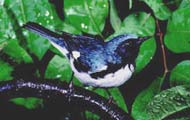Older stories on Resources News
Links to general resource, environmental sites
Links to non-profit environmental/resource groups
Links to environmental/resource news sources
E-mail Resources News
Farming in Forests Destroys Bird Habitat
Opening up forests with farm fields benefits some forms of wildlife species, but not birds. In fact, agricultural operations are more detrimental to bird populations than forest harvesting operations - according to a recent study by a researcher at Ohio State University. The study suggests that farming may make bird nests more vulnerable to predation by squirrels and other animals.
Amanda D. Rodewald, assistant professor of wildlife ecology in the School of Natural Resources, also found that forests with agricultural clearings in them had a lower diversity of bird species and fewer birds than forests in which pockets of tree cover had been cleared by timber harvesting.
"A farm patch in the forest may be more damaging to birds than a clearing left by just the felling of trees," said Rodewald. She says that the most likely reason for the adverse impact of agriculture on nesting success was that the farm patches were somehow helping nest predators to thrive.
"Some parks and forests will allow small agricultural openings within them. Those are the types of management policies that we need to start reconsidering," Rodewald said. "It's not enough to say there are a lot of forests, so the birds in them will be fine. We have to look at land uses right next to the forested zone."
Rodewald looked at a total of 10 forests in the study, all of them in central Pennsylvania. Five had farm patches in them while the remaining five had clearings left by timber harvesting. The forests were roughly equal in size. The researchers surveyed bird populations inside the forests during the breeding seasons between 1997 and 1999.
"The first time we looked into a nest, we would make notes about the number of eggs inside," Rodewald said. "In subsequent observations, we would either find that the eggs had hatched successfully and the chicks were developing feathers - getting ready to fly out - or that the nestlings were gone and the nest had been destroyed. In the second case, we knew that the nest had most likely been visited by a predator."
After accounting for the differences in the amount of disturbance within each forest, Rodewald and her colleague found that nesting success in forested landscapes disturbed by farming was about two-and-a-half times lower than in those disturbed by timber harvesting.
To compare the diversity and abundance of birds in the two kinds of forests, 34 different landscapes were studies - half of them disturbed by agriculture and the other half by timber harvesting. This sample included the 10 forests that Rodewald looked at in their nesting success study.
From the larger survey, the researchers found that the number of bird species in forests disturbed by farming was lower. On average, the abundance of birds in these forests - measured by the population of each species - was smaller as well.
